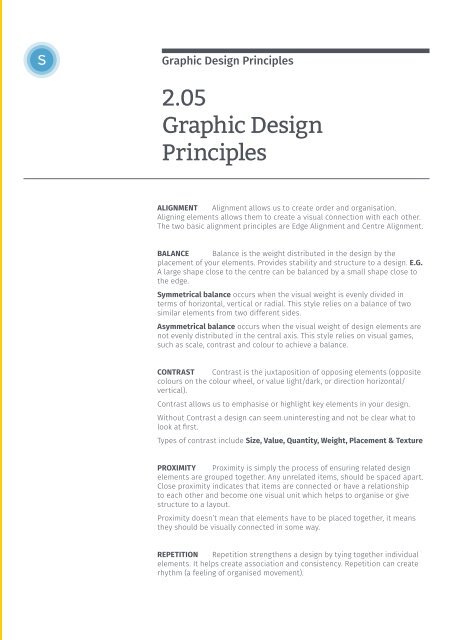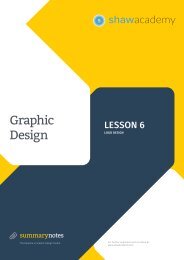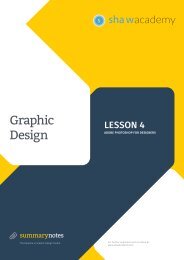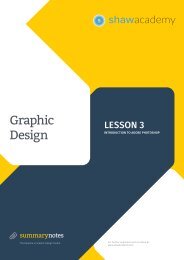Create successful ePaper yourself
Turn your PDF publications into a flip-book with our unique Google optimized e-Paper software.
S<br />
Graphic Design Principles<br />
2.05<br />
Graphic Design<br />
Principles<br />
ALIGNMENT Alignment allows us to create order and organisation.<br />
Aligning elements allows them to create a visual connection with each other.<br />
The two basic alignment principles are Edge Alignment and Centre Alignment.<br />
BALANCE Balance is the weight distributed in the design by the<br />
placement of your elements. Provides stability and structure to a design. E.G.<br />
A large shape close to the centre can be balanced by a small shape close to<br />
the edge.<br />
Symmetrical balance occurs when the visual weight is evenly divided in<br />
terms of horizontal, vertical or radial. This style relies on a balance of two<br />
similar elements from two different sides.<br />
Asymmetrical balance occurs when the visual weight of design elements are<br />
not evenly distributed in the central axis. This style relies on visual games,<br />
such as scale, contrast and colour to achieve a balance.<br />
CONTRAST Contrast is the juxtaposition of opposing elements (opposite<br />
colours on the colour wheel, or value light/dark, or direction horizontal/<br />
vertical).<br />
Contrast allows us to emphasise or highlight key elements in your design.<br />
Without Contrast a design can seem uninteresting and not be clear what to<br />
look at first.<br />
Types of contrast include Size, Value, Quantity, Weight, Placement & Texture<br />
PROXIMITY Proximity is simply the process of ensuring related design<br />
elements are grouped together. Any unrelated items, should be spaced apart.<br />
Close proximity indicates that items are connected or have a relationship<br />
to each other and become one visual unit which helps to organise or give<br />
structure to a layout.<br />
Proximity doesn’t mean that elements have to be placed together, it means<br />
they should be visually connected in some way.<br />
REPETITION Repetition strengthens a design by tying together individual<br />
elements. It helps create association and consistency. Repetition can create<br />
rhythm (a feeling of organised movement).







